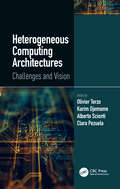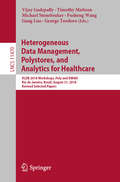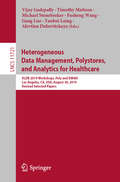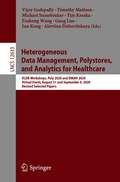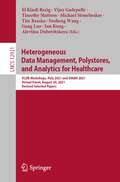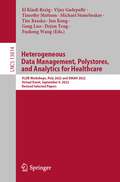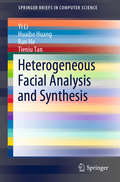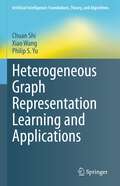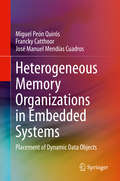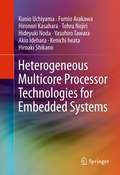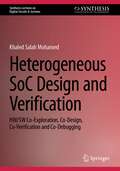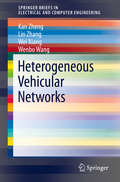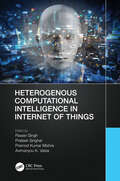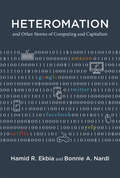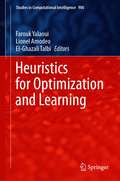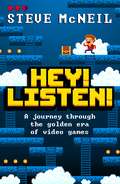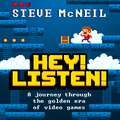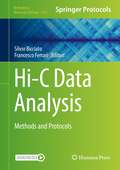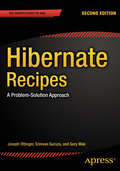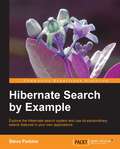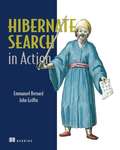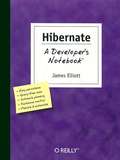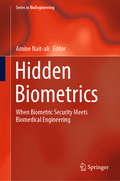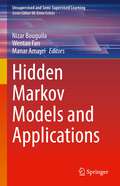- Table View
- List View
Heterogeneous Computing Architectures: Challenges and Vision
by Olivier Terzo, Karim Djemame, Alberto Scionti and Clara PezuelaHeterogeneous Computing Architectures: Challenges and Vision provides an updated vision of the state-of-the-art of heterogeneous computing systems, covering all the aspects related to their design: from the architecture and programming models to hardware/software integration and orchestration to real-time and security requirements. The transitions from multicore processors, GPU computing, and Cloud computing are not separate trends, but aspects of a single trend-mainstream; computers from desktop to smartphones are being permanently transformed into heterogeneous supercomputer clusters. The reader will get an organic perspective of modern heterogeneous systems and their future evolution.
Heterogeneous Data Management, Polystores, and Analytics for Healthcare: VLDB 2018 Workshops, Poly and DMAH, Rio de Janeiro, Brazil, August 31, 2018, Revised Selected Papers (Lecture Notes in Computer Science #11470)
by Michael Stonebraker Fusheng Wang Gang Luo Vijay Gadepally Timothy Mattson George TeodoroThis book constitutes the refereed post-conference proceedings of International Workshops: Polystores and other Systems for Heterogeneous Data, Poly 2018, and Data Management and Analytics for Medicine and Healthcare, DMAH 2018, in Rio de Janeiro, Brazil, in August 2018, held in conjunction with the 44th International Conference on Very Large Data Bases, VLDB 2018. The 11 regular papers presented together with 2 invited papers and 1 abstract of a keynote talk were carefully reviewed and selected from 16 initial submissions. The Poly 2018 Workshop focus on growing a larger and more diverse research agenda around data system solutions for heterogeneous data. The DMAH 2018 Workshop aims to foster exchange of information and discussions on innovative data management and analytics technologies.
Heterogeneous Data Management, Polystores, and Analytics for Healthcare: VLDB 2019 Workshops, Poly and DMAH, Los Angeles, CA, USA, August 30, 2019, Revised Selected Papers (Lecture Notes in Computer Science #11721)
by Michael Stonebraker Fusheng Wang Gang Luo Vijay Gadepally Timothy Mattson Yanhui Laing Alevtina DubovitskayaThis book constitutes the refereed post-conference proceedings for the VLBD conference workshops entitled: Towards Polystores That Manage Multiple Databases, Privacy, Security and/or Policy Issues for Heterogenous Data (Poly 2019) and the Fifth International Workshop on Data Management and Analytics for Medicine and Healthcare (DMAH 2019), held in Los Angeles, CA, USA, in August 2019, in conjunction with the 45th International Conference on Very Large Data Bases, VLDB 2019. The 20 regular papers presented together with 2 keynote papers were carefully reviewed and selected from 31 initial submissions. The papers are organized in topical sections named:Poly 2019: Privacy, Security and/or Policy Issues for Heterogenous Data; Building Polystore Systems.DMAH 2019: Database Enabled Biomedical Research; AI for Healthcare; Knowledge Discovery from Unstructured Biomedical Data; Blockchain and Privacy Preserving Data Management.
Heterogeneous Data Management, Polystores, and Analytics for Healthcare: VLDB Workshops, Poly 2020 and DMAH 2020, Virtual Event, August 31 and September 4, 2020, Revised Selected Papers (Lecture Notes in Computer Science #12633)
by Michael Stonebraker Fusheng Wang Gang Luo Vijay Gadepally Timothy Mattson Alevtina Dubovitskaya Tim Kraska Jun KongThis book constitutes revised selected papers from two VLDB workshops: The International Workshop on Polystore Systems for Heterogeneous Data in Multiple Databases with Privacy and Security Assurances, Poly 2020, and the 6th International Workshop on Data Management and Analytics for Medicine and Healthcare, DMAH 2020, which were held virtually on August 31 and September 4, 2020.For Poly 2020, 4 full and 3 short papers were accepted from 10 submissions; and for DMAH 2020, 7 full and 2 short papers were accepted from a total of 15 submissions. The papers were organized in topical sections as follows: Privacy, Security and/or Policy Issues for Heterogenous Data; COVID-19 Data Analytics and Visualization; Deep Learning based Biomedical Data Analytics; NLP based Learning from Unstructured Data; Biomedical Data Modelling and Prediction.
Heterogeneous Data Management, Polystores, and Analytics for Healthcare: VLDB Workshops, Poly 2021 and DMAH 2021, Virtual Event, August 20, 2021, Revised Selected Papers (Lecture Notes in Computer Science #12921)
by Michael Stonebraker Fusheng Wang Gang Luo Vijay Gadepally Timothy Mattson Alevtina Dubovitskaya Tim Kraska Jun Kong El Kindi RezigThis book constitutes revised selected papers from two VLDB workshops: The International Workshop on Polystore Systems for Heterogeneous Data in Multiple Databases with Privacy and Security Assurances, Poly 2021, and the 7th International Workshop on Data Management and Analytics for Medicine and Healthcare, DMAH 2021, which were held virtually on August 2021. For Poly 2021, 7 full and 2 short papers were accepted from 10 submissions; and for DMAH 2021, 4 full papers together with 2 invited papers were accepted from a total of 7 submissions. The papers were organized in topical sections as follows: distributed information systems in enterprises, enterprise access to data constructed from a variety of programming models, data management, data integration, data curation, privacy, and security innovative data management and analytics technologies highlighting end-to-end applications, systems, and methods to address problems in healthcare.
Heterogeneous Data Management, Polystores, and Analytics for Healthcare: VLDB Workshops, Poly 2022 and DMAH 2022, Virtual Event, September 9, 2022, Revised Selected Papers (Lecture Notes in Computer Science #13814)
by Michael Stonebraker Fusheng Wang Gang Luo Vijay Gadepally Timothy Mattson Tim Kraska Jun Kong El Kindi Rezig Dejun TengThis book constitutes revised selected papers from two VLDB workshops: The International Workshop on Polystore Systems for Heterogeneous Data in Multiple Databases with Privacy and Security Assurances, Poly 2022, and the 8th International Workshop on Data Management and Analytics for Medicine and Healthcare, DMAH 2022, which were held virtually on September 9, 2022. The proceedings include 3 full papers each from Poly 2022 and from DMAH 2022. DMAH deals with innovative data management and analytics technologies highlighting end-to-end applications, systems, and methods to address problems in healthcare, public health, and everyday wellness, with clinical, physiological, imaging, behavioral, environmental, and omic - data, and data from social media and the Web.Poly is focusing on the broader real-world polystore problem, which includes data management, data integration, data curation, privacy, and security.
Heterogeneous Facial Analysis and Synthesis (SpringerBriefs in Computer Science)
by Yi Li Ran He Tieniu Tan Huaibo HuangThis book presents a comprehensive review of heterogeneous face analysis and synthesis, ranging from the theoretical and technical foundations to various hot and emerging applications, such as cosmetic transfer, cross-spectral hallucination and face rotation. Deep generative models have been at the forefront of research on artificial intelligence in recent years and have enhanced many heterogeneous face analysis tasks. Not only has there been a constantly growing flow of related research papers, but there have also been substantial advances in real-world applications. Bringing these together, this book describes both the fundamentals and applications of heterogeneous face analysis and synthesis. Moreover, it discusses the strengths and weaknesses of related methods and outlines future trends. Offering a rich blend of theory and practice, the book represents a valuable resource for students, researchers and practitioners who need to construct face analysis systems with deep generative networks.
Heterogeneous Graph Representation Learning and Applications (Artificial Intelligence: Foundations, Theory, and Algorithms)
by Philip S. Yu Xiao Wang Chuan ShiRepresentation learning in heterogeneous graphs (HG) is intended to provide a meaningful vector representation for each node so as to facilitate downstream applications such as link prediction, personalized recommendation, node classification, etc. This task, however, is challenging not only because of the need to incorporate heterogeneous structural (graph) information consisting of multiple types of node and edge, but also the need to consider heterogeneous attributes or types of content (e.g. text or image) associated with each node. Although considerable advances have been made in homogeneous (and heterogeneous) graph embedding, attributed graph embedding and graph neural networks, few are capable of simultaneously and effectively taking into account heterogeneous structural (graph) information as well as the heterogeneous content information of each node.In this book, we provide a comprehensive survey of current developments in HG representation learning. More importantly, we present the state-of-the-art in this field, including theoretical models and real applications that have been showcased at the top conferences and journals, such as TKDE, KDD, WWW, IJCAI and AAAI. The book has two major objectives: (1) to provide researchers with an understanding of the fundamental issues and a good point of departure for working in this rapidly expanding field, and (2) to present the latest research on applying heterogeneous graphs to model real systems and learning structural features of interaction systems. To the best of our knowledge, it is the first book to summarize the latest developments and present cutting-edge research on heterogeneous graph representation learning. To gain the most from it, readers should have a basic grasp of computer science, data mining and machine learning.
Heterogeneous Memory Organizations in Embedded Systems: Placement of Dynamic Data Objects
by Francky Catthoor Miguel Peón Quirós José Manuel Mendías CuadrosThis book defines and explores the problem of placing the instances of dynamic data types on the components of the heterogeneous memory organization of an embedded system, with the final goal of reducing energy consumption and improving performance. It is one of the first to cover the problem of placement for dynamic data objects on embedded systems with heterogeneous memory architectures, presenting a complete methodology that can be easily adapted to real cases and work flows. The authors discuss how to improve system performance and energy consumption simultaneously.Discusses the problem of placement for dynamic data objects on embedded systems with heterogeneous memory architectures;Presents a complete methodology that can be adapted easily to real cases and work flows;Offers hints on how to improve system performance and energy consumption simultaneously.
Heterogeneous Multicore Processor Technologies for Embedded Systems
by Tohru Nojiri Kenichi Iwata Fumio Arakawa Yasuhiro Tawara Kunio Uchiyama Hironori Kasahara Hiroaki Shikano Hideyuki Noda Akio IdeharaTo satisfy the higher requirements of digitally converged embedded systems, this book describes heterogeneous multicore technology that uses various kinds of low-power embedded processor cores on a single chip. With this technology, heterogeneous parallelism can be implemented on an SoC, and greater flexibility and superior performance per watt can then be achieved. This book defines the heterogeneous multicore architecture and explains in detail several embedded processor cores including CPU cores and special-purpose processor cores that achieve highly arithmetic-level parallelism. The authors developed three multicore chips (called RP-1, RP-2, and RP-X) according to the defined architecture with the introduced processor cores. The chip implementations, software environments, and applications running on the chips are also explained in the book. Provides readers an overview and practical discussion of heterogeneous multicore technologies from both a hardware and software point of view;Discusses a new, high-performance and energy efficient approach to designing SoCs for digitally converged, embedded systems;Covers hardware issues such as architecture and chip implementation, as well as software issues such as compilers, operating systems, and application programs;Describes three chips developed according to the defined heterogeneous multicore architecture, including chip implementations, software environments, and working applications.
Heterogeneous SoC Design and Verification: HW/SW Co-Exploration, Co-Design, Co-Verification and Co-Debugging (Synthesis Lectures on Digital Circuits & Systems)
by Khaled Salah MohamedThis book covers the foundations of hardware/software codesign, on-chip communication, debugging, and verification, for heterogenous SoCs. Its primary objective is to empower designers in making informed decisions, guiding them to strike the perfect balance between flexibility and performance for their SoC designs. Readers will benefit from a detailed exploration of the essential elements of the hardware and software codesign framework, accompanied by a discussion of the driving motivations behind this approach. The author also provides an in-depth review of various hardware design architectures, shedding light on different design possibilities. Furthermore, the book presents key concepts concerning hardware and software communication, unraveling the intricate interactions within an SoC. This book provides a holistic introduction to the methodologies underpinning SoC design and verification, making it an indispensable companion for both novice and experienced designers navigating the ever-evolving landscape of hardware/software codesign.
Heterogeneous Vehicular Networks
by Lin Zhang Kan Zheng Wei Xiang Wenbo WangThis brief examines recent developments in the Heterogeneous Vehicular NETworks (HETVNETs), integrating cellular networks with Dedicated Short-Range Communication (DSRC) for meeting the communications requirements of the Intelligent Transport System (ITS)services. Along with a review of recent literature, a unified framework of the HetVNET is presented. The brief focuses on introducing efficient MAC mechanisms for vehicular communications, including channel access protocols, broadcast/multicast protocols, the location-based channel congestion control scheme and the content-based resource allocation scheme. The cooperative communication between vehicles is discussed. This brief concludes with a discussion on future research directions, and provides the readers with useful insights into the future designs in the HetVNETs, to motivate new ideas for performance improvements in vehicular networks.
Heterogenous Computational Intelligence in Internet of Things
by Prateek Singhal Pawan Singh Pramod Kumar Mishra Avimanyou K. VatsaWe have seen a sharp increase in the development of data transfer techniques in the networking industry over the past few years. We can see that the photos are assisting clinicians in detecting infection in patients even in the current COVID-19 pandemic condition. With the aid of ML/AI, medical imaging, such as lung X-rays for COVID-19 infection, is crucial in the early detection of many diseases. We also learned that in the COVID-19 scenario, both wired and wireless networking are improved for data transfer but have network congestion. An intriguing concept that has the ability to reduce spectrum congestion and continuously offer new network services is providing wireless network virtualization. The degree of virtualization and resource sharing varies between the paradigms. Each paradigm has both technical and non-technical issues that need to be handled before wireless virtualization becomes a common technology. For wireless network virtualization to be successful, these issues need careful design and evaluation. Future wireless network architecture must adhere to a number of Quality of Service (QoS) requirements. Virtualization has been extended to wireless networks as well as conventional ones. By enabling multi-tenancy and tailored services with a wider range of carrier frequencies, it improves efficiency and utilization. In the IoT environment, wireless users are heterogeneous, and the network state is dynamic, making network control problems extremely difficult to solve as dimensionality and computational complexity keep rising quickly. Deep Reinforcement Learning (DRL) has been developed by the use of Deep Neural Networks (DNNs) as a potential approach to solve high-dimensional and continuous control issues effectively. Deep Reinforcement Learning techniques provide great potential in IoT, edge and SDN scenarios and are used in heterogeneous networks for IoT-based management on the QoS required by each Software Defined Network (SDN) service. While DRL has shown great potential to solve emerging problems in complex wireless network virtualization, there are still domain-specific challenges that require further study, including the design of adequate DNN architectures with 5G network optimization issues, resource discovery and allocation, developing intelligent mechanisms that allow the automated and dynamic management of the virtual communications established in the SDNs which is considered as research perspective.
Heteromation, and Other Stories of Computing and Capitalism (Acting with Technology)
by Bonnie A. Nardi Hamid R. EkbiaAn exploration of a new division of labor between machines and humans, in which people provide value to the economy with little or no compensation.The computerization of the economy—and everyday life—has transformed the division of labor between humans and machines, shifting many people into work that is hidden, poorly compensated, or accepted as part of being a “user” of digital technology. Through our clicks and swipes, logins and profiles, emails and posts, we are, more or less willingly, participating in digital activities that yield economic value to others but little or no return to us. Hamid Ekbia and Bonnie Nardi call this kind of participation—the extraction of economic value from low-cost or free labor in computer-mediated networks—“heteromation.” In this book, they explore the social and technological processes through which economic value is extracted from digitally mediated work, the nature of the value created, and what prompts people to participate in the process.Arguing that heteromation is a new logic of capital accumulation, Ekbia and Nardi consider different kinds of heteromated labor: communicative labor, seen in user-generated content on social media; cognitive labor, including microwork and self-service; creative labor, from gaming environments to literary productions; emotional labor, often hidden within paid jobs; and organizing labor, made up of collaborative groups such as citizen scientists. Ekbia and Nardi then offer a utopian vision: heteromation refigured to bring end users more fully into the prosperity of capitalism.
Heuristics for Optimization and Learning (Studies in Computational Intelligence #906)
by Lionel Amodeo Farouk Yalaoui El-Ghazali TalbiThis book is a new contribution aiming to give some last research findings in the field of optimization and computing. This work is in the same field target than our two previous books published: “Recent Developments in Metaheuristics” and “Metaheuristics for Production Systems”, books in Springer Series in Operations Research/Computer Science Interfaces. The challenge with this work is to gather the main contribution in three fields, optimization technique for production decision, general development for optimization and computing method and wider spread applications. The number of researches dealing with decision maker tool and optimization method grows very quickly these last years and in a large number of fields. We may be able to read nice and worthy works from research developed in chemical, mechanical, computing, automotive and many other fields.
Hey Cyba: The Inner Workings of a Virtual Personal Assistant
by Steve YoungRecent developments in artificial intelligence, especially neural network and deep learning technology, have led to rapidly improving performance in voice assistants such as Siri and Alexa. Over the next few years, capability will continue to improve and become increasingly personalised. Today's voice assistants will evolve into virtual personal assistants firmly embedded within our everyday lives. Told through the view of a fictitious personal assistant called Cyba, this book provides an accessible but detailed overview of how a conversational voice assistant works, especially how it understands spoken language, manages conversations, answers questions and generates responses. Cyba explains through examples and diagrams the neural network technology underlying speech recognition and synthesis, natural language understanding, knowledge representation, conversation management, language translation and chatbot technology. Cyba also explores the implications of this rapidly evolving technology for security, privacy and bias, and gives a glimpse of future developments. Cyba's website can be found at HeyCyba.com.
Hey! Listen!: A journey through the golden era of video games
by Steve McNeilFor fans of Daniel Hardcastle's Fuck Yeah!, Videogames and Retro Tech by peter leigh.Equal parts hilarious and informative, Hey! Listen! should be in every gamer's library. - Lucy James, (Gamespot) An informative, accessible romp through the early years of the games industry. All hail Il pirata pallido; the gaming hero we never knew we needed.- Adam Rosser BBC Radio 5LiveSteve McNeil is funny, knowledgeable, and a massive, shameless, nerd. His brilliant book reminded me just how much of my life I've wasted. If the Golden Age of Gaming is a horse, then Steve's book is the stable. - Paul Rose (aka Mr Biffo), DigitiserA thoroughly enjoyable look at the early days of video gaming - comprehensive and fun. Loved it! - Stuart Ashen (aka ashens)The 'A La Recherche du Temps Perdu' of the gaming community. The 'A La Recherche du Temps Pew-Pew-Pew', as it were. - Dara O'BriainIf 'Games Master' was a Nobel title passed on through the ages like 'Duke of York' or 'Rear of the Year' rather than simply the name of a 90s magazine and TV show then Steve McNeil would surely be the current holder of the esteemed position. What I'm saying is, he knows a LOT about games... - Scroobius PipTaking us on a historical journey from the very early days all the way through to the late 1990s the book tells the stories of the men and women behind some of the most wonderful (and occasionally awful) games of the golden age, the fierce rivalries, bizarre business practices and downright bonkers risks taken during the pioneering days of computer and video gaming. This informal yet extremely well-researched book manages to educate and entertain in equal measure and this - dare I say - well-informed retrohead actually learnt a good deal. A thoroughly enjoyable read! - Mark Howlett (aka Lord Arse)Hugely funny, and full of fantastic facts about the history of video games. But enough about me; Steve's book is also quite good. - Ellie Gibson, EurogamerA hilarious history of the golden period of computer games from the creator of Dara O'Briain's Go 8 Bit.It is fair to say Steve McNeil likes video games. He took a Nintendo Wii with him on his honeymoon (obviously), and spent so much time playing smartphone games in bed in the dark that he got eye strain and had to wear an eye patch. The locals nicknamed him 'the pale pirate'.Steve's obsession with video games can be traced back to the golden period from the early 70s to the late 90s. In this book he will delve into these games - from the appallingly bad to the breathtakingly good. He will also take us through the nerdy geniuses who created them, their fierce rivalries and risks often leading to some of the most farcical moments in the history of entertainment.This is a story of obsession, full of tales of Space Invaders, Donkey Kong, Mario, Sonic, Wolfenstein 3D, Worms and many more. It will also answer important questions about the golden age. Questions like: Why did Namco feel they had to change the name of Puck-Man to Pac-Man because they were worried about graffiti, when Nintendo were more than happy to bring out Duck Hunt?Joysticks at the ready. Let's do a gaming!
Hey! Listen!: A journey through the golden era of video games
by Steve McNeilFor fans of Daniel Hardcastle's Fuck Yeah!, Videogames and Retro Tech by peter leigh.Equal parts hilarious and informative, Hey! Listen! should be in every gamer's library. - Lucy James, (Gamespot) An informative, accessible romp through the early years of the games industry. All hail Il pirata pallido; the gaming hero we never knew we needed.- Adam Rosser BBC Radio 5LiveSteve McNeil is funny, knowledgeable, and a massive, shameless, nerd. His brilliant book reminded me just how much of my life I've wasted. If the Golden Age of Gaming is a horse, then Steve's book is the stable. - Paul Rose (aka Mr Biffo), DigitiserA thoroughly enjoyable look at the early days of video gaming - comprehensive and fun. Loved it! - Stuart Ashen (aka ashens)The 'A La Recherche du Temps Perdu' of the gaming community. The 'A La Recherche du Temps Pew-Pew-Pew', as it were. - Dara O'BriainIf 'Games Master' was a Nobel title passed on through the ages like 'Duke of York' or 'Rear of the Year' rather than simply the name of a 90s magazine and TV show then Steve McNeil would surely be the current holder of the esteemed position. What I'm saying is, he knows a LOT about games... - Scroobius PipTaking us on a historical journey from the very early days all the way through to the late 1990s the book tells the stories of the men and women behind some of the most wonderful (and occasionally awful) games of the golden age, the fierce rivalries, bizarre business practices and downright bonkers risks taken during the pioneering days of computer and video gaming. This informal yet extremely well-researched book manages to educate and entertain in equal measure and this - dare I say - well-informed retrohead actually learnt a good deal. A thoroughly enjoyable read! - Mark Howlett (aka Lord Arse)Hugely funny, and full of fantastic facts about the history of video games. But enough about me; Steve's book is also quite good. - Ellie Gibson, EurogamerA hilarious history of the golden period of computer games from the creator of Dara O'Briain's Go 8 Bit.It is fair to say Steve McNeil likes video games. He took a Nintendo Wii with him on his honeymoon (obviously), and spent so much time playing smartphone games in bed in the dark that he got eye strain and had to wear an eye patch. The locals nicknamed him 'the pale pirate'.Steve's obsession with video games can be traced back to the golden period from the early 70s to the late 90s. In this book he will delve into these games - from the appallingly bad to the breathtakingly good. He will also take us through the nerdy geniuses who created them, their fierce rivalries and risks often leading to some of the most farcical moments in the history of entertainment.This is a story of obsession, full of tales of Space Invaders, Donkey Kong, Mario, Sonic, Wolfenstein 3D, Worms and many more. It will also answer important questions about the golden age. Questions like: Why did Namco feel they had to change the name of Puck-Man to Pac-Man because they were worried about graffiti, when Nintendo were more than happy to bring out Duck Hunt?Joysticks at the ready. Let's do a gaming!
Hi-C Data Analysis: Methods and Protocols (Methods in Molecular Biology #2301)
by Silvio Bicciato Francesco FerrariThis volume details a comprehensive set of methods and tools for Hi-C data processing, analysis, and interpretation. Chapters cover applications of Hi-C to address a variety of biological problems, with a specific focus on state-of-the-art computational procedures adopted for the data analysis. Written in the highly successful Methods in Molecular Biology series format, chapters include introductions to their respective topics, lists of the necessary materials and reagents, step-by-step, readily reproducible laboratory protocols, and tips on troubleshooting and avoiding known pitfalls.Authoritative and cutting-edge, Hi-C Data Analysis: Methods and Protocols aims to help computational and molecular biologists working in the field of chromatin 3D architecture and transcription regulation.
Hibernate Recipes
by Joseph Ottinger Srinivas Guruzu Gary MakHibernate Recipes, Second Edition contains a collection of code recipes and templates for learning and building Hibernate solutions for you and your clients, including how to work with the Spring Framework and the JPA. This book is your pragmatic day-to-day reference and guide for doing all things involving Hibernate. There are many books focused on learning Hibernate, but this book takes you further and shows how you can apply it practically in your daily work. Hibernate Recipes, Second Edition is a must have book for your library. Hibernate 4. x continues to be the most popular out-of-the-box, open source framework solution for Java persistence and data/database accessibility techniques and patterns and it works well with the most popular open source enterprise Java framework of all, the Spring Framework. Hibernate is used for e-commerce-based web applications as well as heavy-duty transactional systems for the enterprise.
Hibernate Search by Example
by Steve PerkinsA step-by-step guide for getting started with Hibernate Search, employing a practical example application that will make readers quickly learn and use the excellent search capabilities that the Hibernate Search tool offers.This book is for any Java developer who wants to quickly and easily add feature-rich search capabilities to his/her custom applications. It is assumed that readers will have experience in Java development, and understand some basic relational database concepts. However, while core Hibernate experience is very helpful, it is not necessarily required.
Hibernate Search in Action
by John Griffin Emmanuel BernardEnterprise and web applications require full-featured, "Google-quality" searchcapabilities, but such features are notoriously difficult to implement and maintain.Hibernate Search builds on the Lucene feature set and offers an easyto-implement interface that integrates seamlessly with Hibernate-the leadingdata persistence solution for Java applications.Hibernate Search in Action introduces both the principles of enterprise searchand the implementation details a Java developer will need to use HibernateSearch effectively. This book blends the insights of the Hibernate Search leaddeveloper with the practical techniques required to index and manipulate data,assemble and execute search queries, and create smart filters for better searchresults. Along the way, the reader masters performance-boosting concepts likeusing Hibernate Search in a clustered environment and integrating with thefeatures already in your applications.This book assumes you're a competent Java developer with some experienceusing Hibernate and Lucene. Purchase of the print book comes with an offer of a free PDF, ePub, and Kindle eBook from Manning. Also available is all code from the book.
Hibernate: A Developer's Notebook
by James ElliottHibernate: A Developer's Notebook shows you how to use Hibernate to automate persistence: you write natural Java objects and some simple configuration files, and Hibernate automates all the interaction between your objects and the database. You don't even need to know the database is there, and you can change from one database to another simply by changing a few statements in a configuration file. If you've needed to add a database backend to your application, don't put it off. It's much more fun than it used to be, and Hibernate: A Developer's Notebook shows you why.
Hidden Biometrics: When Biometric Security Meets Biomedical Engineering (Series in BioEngineering)
by Amine Nait-AliThis book explores intrinsic and human body part biometrics and biometrics of human physiological activities, invisible to the naked eye. This includes, for instance, brain structures, skeleton morphology, heart activity, etc. These human body parts can only be visualized using specific imaging techniques or sensors, commonly employed in the biomedical engineering field. As such, the book connects two fields, namely biometric security and biomedical engineering.The book is suitable for advanced graduate and postgraduate students, engineers and researchers, especially in Signal and Image Processing, Biometrics, and Biomedical Engineering.
Hidden Markov Models and Applications (Unsupervised and Semi-Supervised Learning)
by Nizar Bouguila Wentao Fan Manar AmayriThis book focuses on recent advances, approaches, theories, and applications related Hidden Markov Models (HMMs). In particular, the book presents recent inference frameworks and applications that consider HMMs. The authors discuss challenging problems that exist when considering HMMs for a specific task or application, such as estimation or selection, etc. The goal of this volume is to summarize the recent advances and modern approaches related to these problems. The book also reports advances on classic but difficult problems in HMMs such as inference and feature selection and describes real-world applications of HMMs from several domains. The book pertains to researchers and graduate students, who will gain a clear view of recent developments related to HMMs and their applications.
